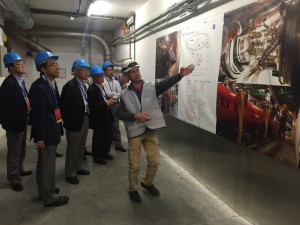
On their visit to CERN and DESY, the civil engineers from Japan also visited the tunnel of the European XFEL. Image: DESY
A delegation from the Japan Society of Civil Engineers including its president took to Europe last month to have a look at civil engineering project for large science facilities. They visited CERN and DESY to look at past and current building projects, which they would use as a reference in case ILC is constructed in Japan.
The Japan Society of Civil Engineers (JSCE) is a society with more than 100 years of tradition and some 39,000 members. Its president is Noriaki Hirose, who was accompanied by four experts on from different companies whose specialities include tunnel engineering, water management and civil consulting and whose have been and are involved in many very different civil construction projects all around the world. KEK’s civil engineering expert Masanobu Miyahara and KEK visiting professor Katsuji Akita, an expert on Shinkansen construction in Japan, travelled with them.
At CERN, the group visited the two major experiment facilities of the LHC, ATLAS and CMS, and at DESY they saw the tunnel and injector building of the European XFEL as well as the tunnel of the decommissioned HERA accelerator and one of its experimental halls. “I think the visit gave them a better understanding about the similarities and differences between accelerator, railway and road tunnels,” Miyahara summarises. “I expect that it’s very meaningful for our coming ILC project that Japanese experts of civil engineering works understand the real state of large-scale accelerator project by this first-hand visit.”
The delegation noted the consideration for environmental issues during the construction of large accelerators at both CERN and DESY. They also realized the importance of the “human environment:” I would like to express my respect to that it is an effort to build good relations with local residents,”Hirose said. “We learned many things and received a lot of suggestions that should be used as a reference.”
Akira Yamamoto, who welcomed the delegation at CERN together with CERN and ILC civil engineer John Osborne, said: “I was very pleased to assist their visiting CERN and DESY and to help them see real experiences of “design to realisation” from the LHC accelerator construction and the European XFEL SRF accelerator. I believe it has been a real “one look tells you more than a thousand words” experience. I would thank my colleagues at CERN and DESY for their kindest cooperation to have received them.”
Miyahara adds that it transpired in discussions that the delegation saw the accelerators as the extremely sophisticated machines they are. “We talked about the fact that the interface between the civil designer and the accelerator researchers is so important above all from the plan stage.”
The JSCE has been very interested in the realisation of ILC project and very closely working with KEK to integrate the ILC civil engineering study for about 10 years.


Recent Comments